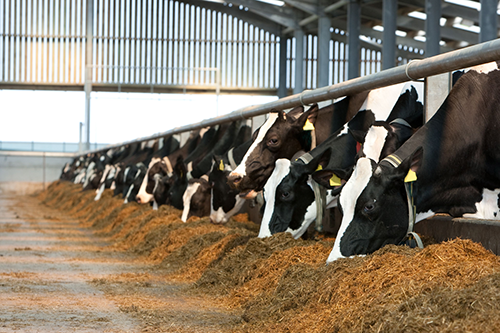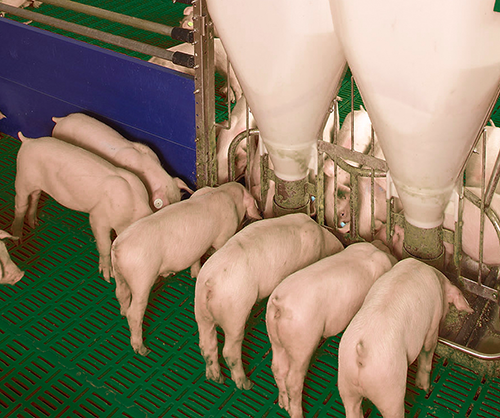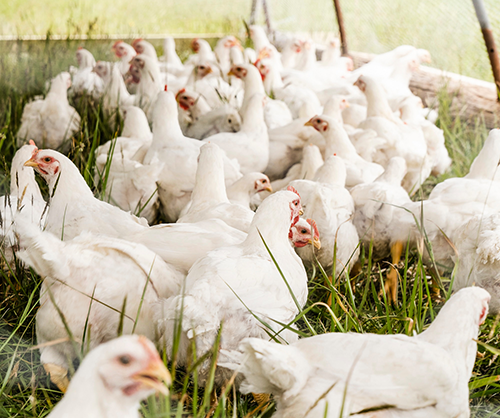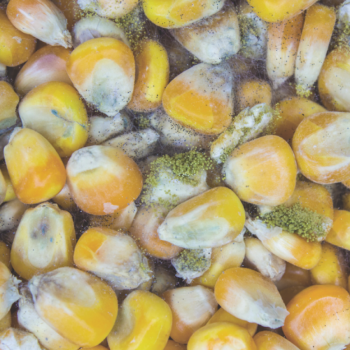
Mycotoxins and mycotoxicosis in livestock production
Mycotoxicosis refers to different diseases caused by exposure to different mycotoxins.
Mycotoxins rarely occur at concentrations high enough to cause immediate expression of clinical symptoms. Mycotoxins are more frequently present in animal feed at low concentrations, producing subclinical symptoms over a certain period of time. It makes it more difficult to diagnose and has serious effects of greater economic importance.
Mycotoxicosis often results from the action of several mycotoxins ingested by animals.
Since some mycotoxigenic fungi are known to produce different kinds of mycotoxins, and feed raw materials are commonly contaminated with different fungi species at a time, different mycotoxins can occur simultaneously in feedstuffs.
A large number of studies have shown toxicological interactions between different mycotoxins.
Therefore, it is important to test for an array of mycotoxins rather than for a single one in order to analyse feed quality and potential risks.
Major mycotoxins in animal feed
There are over 300 mycotoxins discovered. The greatest concern for animal and human health is caused by mycotoxins produced mostly by species of genus Aspergillus, Fusarium and Penicillium.
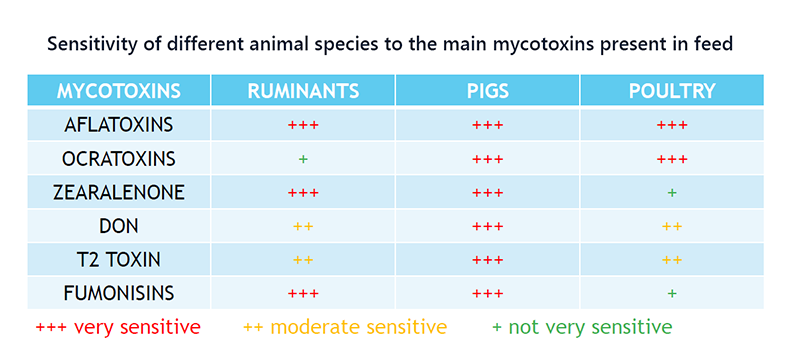
Aflatoxins
Aflatoxins are a group of mycotoxins produced by two ubiquitous species of Aspergillus.
Peanut cake, palm kernel, copra and corn gluten meal are considered to be the primal source of aflatoxin exposure.
Toxigenic Aspergillus flavus produce aflatoxins В1 and В2, while toxigenic Aspergillus parasiticus produce aflatoxins В1, В2, G1 and G2.
Among all afore-mentioned species, aflatoxin В1 is considered to be the most prevalent and toxic compound for animals and human.
Aflatoxins are liposoluble compounds, and therefore are easily absorbed along throughout the digestive tract. Aflatoxin B1 metabolism has been thoroughly studied.
It is known that this mycotoxin is metabolised in the liver, which results in the formation of five main metabolites – some of them have mutagenic, carcinogenic and teratogenic effects and are capable of diminishing protein production.
Aflatoxin М1, being one of aflatoxin B1 metabolites, is excreted through milk in significant concentrations, and is thought to have hepatotoxic and carcinogenic effects in human. Furthermore, aflatoxin B1 metabolites can also be found in muscular tissues of different livestock species and poultry, and therefore in meat intended for human consumption, as well as in eggs of laying hens.
In pigs, symptoms of acute poisoning with this mycotoxin appear right after consumption of highly contaminated feed; these include depression, anorexia, jaundice, haemorrhages, ataxia, diarrhoea and even death. Chronic intoxication results in long-term economic losses, associated with drops in daily weight gain, feed intake, worsened feed conversion ratio, etc.
Occasionally, scaly skin or purple colouring, lethargy and depression can be observed in animals.
Symptoms of aflatoxin intoxication vary among poultry species from decreased feed intake and weight loss to a drop in hatchability and fertility, egg production and weight.
| Chronic intoxication in ruminants results in weight loss, abortions, abnormal oestrus cycle, decreased milk production, development of mastitis, diarrhoea and respiratory disorders. |
|
Fumonisins
Fumonisins are a group of mycotoxins mainly produced by fungi of the genus Fusarium.
The most important toxins are those belonging to Group B – fumonisins В1, В2 and В3, among which fumonisin B1 is the most toxic and frequent one. Fumonisins in Group B are toxic to both animals and human and are classified as Group 2B of carcinogenic substances.
Fumonisins are almost exclusively found in maize, including maize kernels, silage and by-products.
Fumonisins are stable at high temperatures and resistant to fermentation; they can be found even in processed feedstuffs.
Fumonisins chemically resemble sphinganine and sphingosine, responsible for the synthesis of sphingolipids, which are structural compounds of cell membranes present in different tissues, especially in those of the nervous system. These mycotoxins can disrupt the metabolism of sphingolipids, causing alterations in cell growth and differentiation, apoptosis and necrosis.
These mycotoxins are eliminated mainly through faeces, though a certain amount can be excreted through eggs in laying hens and milk in dairy cows when high doses of fumonisins are consumed.
Dairy cows show a decrease in feed intake and milk production.
In poultry, symptoms of fumonisin poisoning range from a decrease in feed intake and weight gain to a decrease in egg production and an increase in mortality.
| Swine and horses are the most sensitive species to fumonisins, especially to fumonisin B1. Chronic intoxication in pigs is characterised by low feed intake and weight gain, hepatic encephalopathy syndrome, hyperplastic oesophagitis, gastric ulceration, heart and pulmonary arteries hypertrophy. |
|
Ochratoxins
Ochratoxins are a group of secondary metabolites produced by species of Penicillium and Aspergillus.
There are seven known ochratoxins. Among those, ochratoxin A causes the greatest concern, which is related to its toxicological significance, carry-over capacity into human food, frequent presence in feedstuffs, stability against cooking and fermenting processes, and also possible significance as human carcinogen.
Ochratoxin A is mainly found in barley, wheat and rye.
In ruminants, ochratoxin А is metabolised by the ruminal microflora into less toxic compounds. Once ochratoxin A reaches the bloodstream, it binds to serum proteins, especially albumin, conferring ochratoxin A an elevated half-life in blood serum; therefore, ochratoxin A can be found in lood-based products, such as bloodpudding or additives made of pig blood or pig plasma. Residual concentratinos of ochratoxin А can be detected in the liver, muscular and adipose tissues, eggs and milk.
Ochratoxin А inhibits protein synthesis by competing with phenylalanine amino acid and also promotes cell oxidation.
Swine is one the most sensitive to ochratoxin A among all livestock species.
This mycotoxin primarily affects kidneys and reduces sperm production and quality in boars. Animals intoxicated with ochratoxin A suffer from polydipsia up to four times the normal water intake, and polyuria as a consequence. These symptoms can be accompanied by diarrhoea, bloody urine, decreased feed intake, feed efficiency and weight gain.
| Poultry species show altered performace: reduced feed intake, feed conversion, weight gain and egg production. |
|
Zearalenone
Zearalenone is a mycotoxin produced by different species of the Fusarium genus. It almost always co-occurs with other Fusarium toxins, such as deoxynivalenol (DON).
Zearalenone is particularly found in maize kernels, cultivated in temperate and warm regions, but it can be also found in othr cereal crops, such as wheat, barley or rice, and occasionally in sorghum and soy beans.
Zearalenone resists to high temperatures and shows good stability during storage and processing: therefore, it can be found in processed feed and food.
As a detoxifying mechanism, plants can chemically modify zearalenone into deoxynivalenol via acetylation, glucosidation and sulphation.
The resulting metabolites, which are toxic to animals, are often undetectable using standard laboratory techniques. Failure to detect these metabolites can lead to underestimating the toxic potential of feeds.
It has been reported that the gut microbiota is able to hydrolyse such “masked” mycotoxins and release their native forms, that is, zearalenone and deoxynivalenol.
Zearalenone is an estrogenic compound that binds competitively estrogen receptors in different tissues (especially in uterus, mammary gland and liver) and generates estrogen-like response.
Zearalenone is metabolised mainly in the liver, producing two major metabolites, both of which have binding affinity to estrogen receptors. Due to its estrogenic activity, zearalenone affects females over males and young animals (especially young females).
Pigs seem to be most susceptible to zearalenone, showing such symptoms of intoxication as hyperaemia, oedematous vulva, enlarged uterus, ovaries or mammary gland, and occasionally vaginal or rectal prolapse. Zearalenone also produces teratogenic effects in piglets, affecting embryonic survival. In males, zearalenone induces a reduction in weight of testes and sperm quality.
Poultry is less susceptible to zearalenone, with adverse effects only observed at very high doses of the mycotoxin which is unusual under field conditions.
Cattle seems to be more resistant to estrogenic effects of zearalenone as this mycotoxin can be degraded in the rumen.
Trichothecenes
Trichothecenes are a group of chemically related compounds that are produced by a large number of fungi and can be classified into four different chemical groups: Types А, В, С and D trichothecenes.
Trichothecenes produced by Fusarium species cause the greatest concern for the livestock production; these mycotoxins include Type A and Type B trichothecenes. Type A trichothecenes include Т-2 toxin and its metabolite НТ-2 toxin, while Type B trichothecenes include deoxynivalenol.
DON, T-2 and HT-2 toxins usually occur in warm climates along with other Fusarium mycotoxins, such as zearalenone and fumonisins.
Concentrations of T-2 and HT-2 toxins in wheat, rye and oats are found to be highly correlated. Among all trichothecenes, DON is the most frequently occurring toxin, though it is about 100 times less toxic than T-2 toxin. Т-2 and НТ-2 toxins are tightly bound to the outer hull of cereal grains, hence by-products, resulted from de-hulling of cereals to be used in the feed industry, may contain greater concentrations of these two toxins.
Trichothecenes inhibit protein synthesis, interact with proteins and cause oxidative stress by generating free radicals. Besides, T-2 toxin induces cell apoptosis in the digestive tract.
Pigs are very sensitive to DON. In pigs, exposure to trichothecenes can cause immunosuppression, vomiting, diarrhoea, gastric and intestinal haemorrhage, dermatitis, feed refusal, weight loss and lower milk production among other problems. Vomiting has been observed at high doses of DON in feed, making this toxin to be commonly known as “vomitoxin”.
Broilers and laying hens appear to be less sensitive to this mycotoxin. At low dietary concentrations in chicken, DON causes a reduction in feed consumption, while its high concentrations result in weight loss, immunosuppression and decreased nutrient absorption in the intestine.
Ruminants are more resistant to DON, which is attributed to its effective metabolism by rumen bacteria.
In poultry, acute trichothecene intoxication leads to nervous symptomatology: hyperpnoea, lethargy, loss of balance and head dropping appear within a few minutes and then rapidly disappear. Soon after, digestive problems follow, characterised by repeated deglutition, diarrhoea, feed refusal and haemorrhages in the digestive tract. Chronic intoxication results in alterations in production and reproductive performance, skin and mucosa lesions, as well as immune system alterations in different poultry species.
Ruminants are more resistant to trichothecenes as these toxins are metabolised in the rumen; T-2 intoxication in cattle causes feed refusal, gastroenteritis and gastrointestinal lesions, intestinal haemorrhages, ruminal ulcers, and even death. Decreased feed intake, milk production and abnormal oestrus cycle have been reported as observed effects in dairy cattle.
It is T-2 toxin metabolism and biotransformation that allows prevention of its accumulation in animal tissues. However, it has been shown that transfer to milk is possible.
Mycotoxicosis prevention
There is no effective treatment of the intoxication once clinical signs have appeared. Even if the animal recovers from intoxication, its performance will remain low.
It is then important to emphasise the necessity of avoiding mycotoxicosis either by preventing mould contamination and mycotoxin formation or by eliminating mycotoxins in feedstuffs.
It is not always feasible to prevent the formation of mycotoxins in feed. Even if mycotoxigenic fungi have been eliminated from feed, some mycotoxins can still be present in feedstuffs due to their high stability.
Therefore, the elimination of mycotoxins in feed is the only way to ensure prevention of mycotoxicosis in animals.
Different methods for mycotoxin elimination in animal feed have been reported, ranging from inclusion of natural compounds (such as organic acids) to physical methods (X-ray or UV light), microbiological methods (enzymes produced by microorganisms) and chemical methods (oxidant agents or mycotoxin adsorbents among others).
The most implemented method is the addition of natural clays, because of their low cost, simple application and the absence of any adverse effect in animals. Such clays adsorb mycotoxins that may be present in feedstuffs, thus preventing their absorption.
Our solution
Nufoer has developed a series of mycotoxin binders branded as Nufotox, assuring the quality of the ingredients used and excluding any drug or pharmaceutical compound.
Our series is comprised of several mycotoxin adsorbents, ranging from basic mycotoxin binder Nufotox, which is 100 per cent made of natural clay (Hydrated Sodium, Calcium and Aluminium Silicate, HSCAS). In particular, our product line includes binder Nufotox Plus enriched with enzymes and mananooligosacharides.
Why is it necessary to add anything except for adsorbent substances to the mycotoxin binder formulation?
There are many different moulds and mycotoxins that affect animals differently. It is necessary not just to ensure the binding activity of HSCAS, but also to help animals to recover from intoxication, improve feed digestibility and boost the immune system. Each ingredient of Nufoer’s mycotoxin inactivator Nufotox Plus is designed to prevent or minimise the reduction in livestock performance associated from the mycotoxin ingestion.
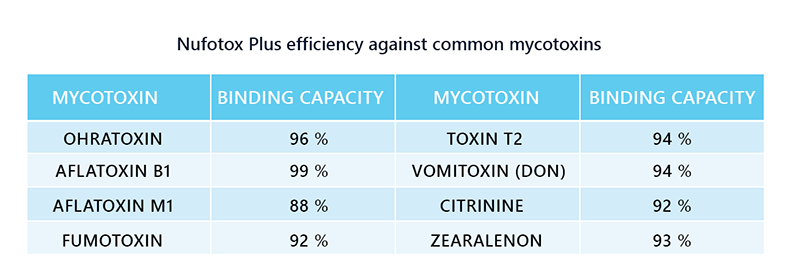
By Francisco J. Martínez and Fernando Aguado, Madrid, Spain





